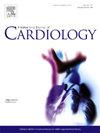The prognostic role of Fibrosis-4 score in heart failure with reduced ejection fraction
IF 3.2
2区 医学
Q2 CARDIAC & CARDIOVASCULAR SYSTEMS
引用次数: 0
Abstract
Background
Heart failure with reduced ejection fraction (HFrEF) and metabolic dysfunction-associated steatotic liver disease (MASLD) are both associated with liver fibrosis. HFrEF patients may develop liver fibrosis due to hepatic congestion, MASLD, or a combination of both. The Fibrosis-4 (FIB-4) score calculated using age, aspartate aminotransferase, alanine aminotransferase, and platelet count, serves as a screening tool for advanced liver fibrosis. This study examines the association between the FIB-4 score and all-cause mortality, cardiovascular mortality, and major adverse liver outcomes (MALO) in patients with HFrEF.
Method and results
This study included 4523 HFrEF patients from the Danish Heart Failure Registry. Based on FIB-4 score, 25.5 % were low-risk, 45.7 % were indeterminate-risk, and 28.8 % were high-risk for advanced liver fibrosis. After five years, the cumulative incidence of all-cause mortality was 43 % for the high-risk group, 36 % for the indeterminate-risk group, and 23 % for the low-risk group. The indeterminate-risk and high-risk group had an increased hazard ratio (HR) for all-cause mortality (HR 1.33, 95 % confidence interval [CI] 1.16–1.52; HR 1.51, 95 % CI 1.31–1.74) compared to the low-risk group. Similarly, HRs were elevated for cardiovascular mortality (HR 1.61, 95 % CI 1.27–2.05; HR 2.14, 95 % CI 1.67–2.74) and MALO (HR 1.77, 95 % CI 1.01–3.31; HR 2.54, 95 % CI 1.43–4.52).
Conclusion
A high FIB-4 score in patients with HFrEF is associated with increased mortality and MALO.

求助全文
约1分钟内获得全文
求助全文
来源期刊

International journal of cardiology
医学-心血管系统
CiteScore
6.80
自引率
5.70%
发文量
758
审稿时长
44 days
期刊介绍:
The International Journal of Cardiology is devoted to cardiology in the broadest sense. Both basic research and clinical papers can be submitted. The journal serves the interest of both practicing clinicians and researchers.
In addition to original papers, we are launching a range of new manuscript types, including Consensus and Position Papers, Systematic Reviews, Meta-analyses, and Short communications. Case reports are no longer acceptable. Controversial techniques, issues on health policy and social medicine are discussed and serve as useful tools for encouraging debate.
 求助内容:
求助内容: 应助结果提醒方式:
应助结果提醒方式:


